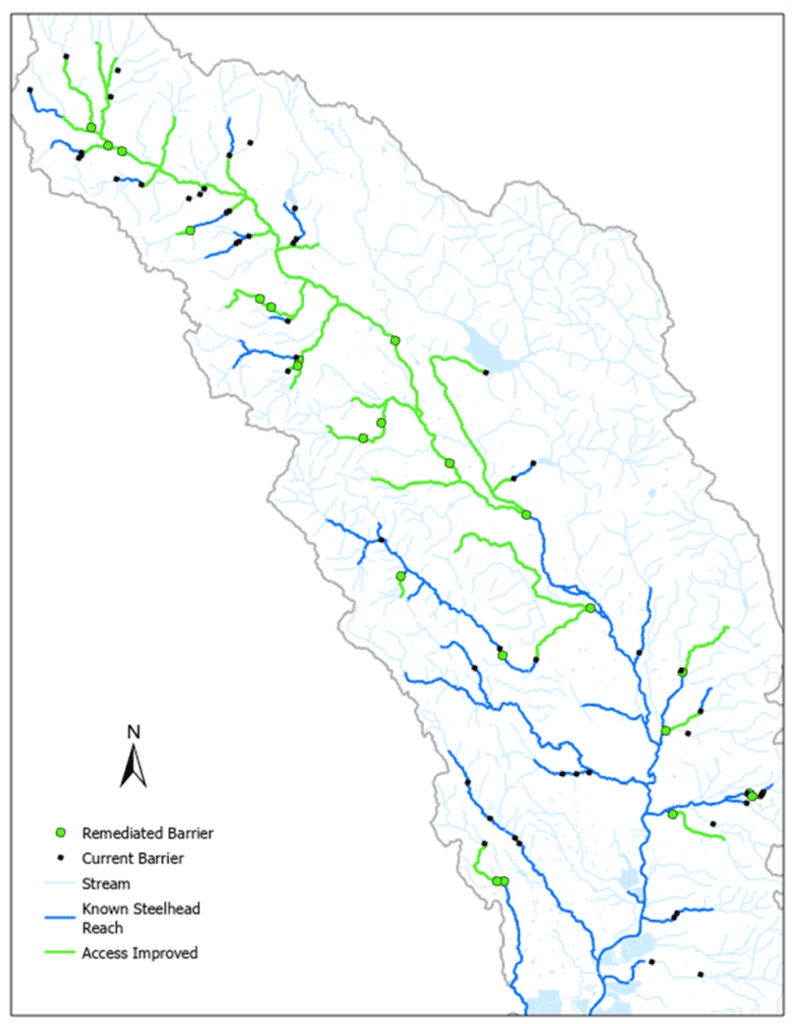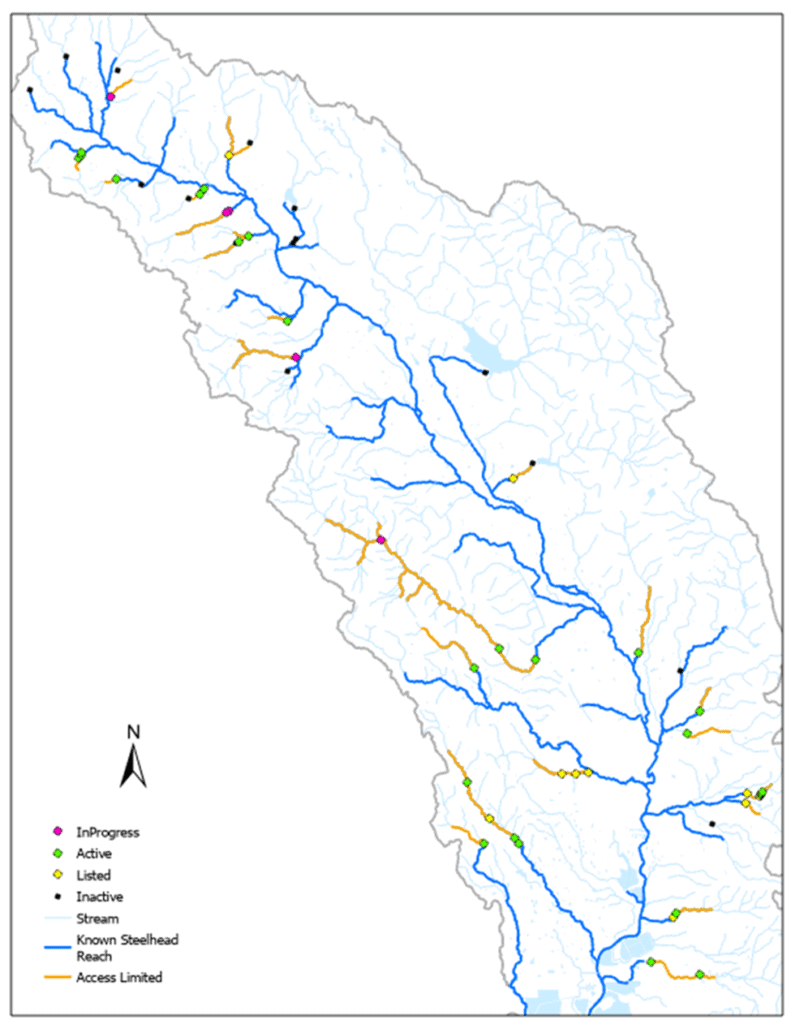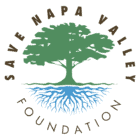Draft last updated: May 5, 2023
Contact: Lucas Patzek, Napa County Resource Conservation District, Lucas@NapaRCD.org, 707-690-3119
Napa County Resource Conservation District (“Napa RCD”) is coordinating a renewed effort to remediate artificial fish migration barriers across the Napa River watershed (approximately 430 square miles). This project will take a strategic prioritized approach at the watershed scale, and bundles implementation, design, and ranking with a focus on 36 identified barriers. Our intention is to use a voluntary approach to provide fish access to as much habitat as possible within the watershed with emphasis on four native anadromous species. The project will be guided by an advisory committee composed of scientists, engineers, and permitting specialists from resource agencies and academia, as well as Tribal and community representatives. Collaborating in all phases of the project will foster learning, enhance trust and risk tolerance, and ultimately make for better outcomes that enhance the pace and scale of habitat restoration in the Napa River watershed.
The Napa River watershed is a complex mosaic of aquatic habitats resulting from variable geology, topography, rainfall patterns, and connection to the ocean through the San Francisco Estuary. Today, the watershed supports 16 native fish species including four anadromous ones: steelhead trout (Oncorhynchus mykiss), chinook salmon (O. tshawytscha), pacific lamprey (Entosphenus tridentatus), and river lamprey (Lampetra ayresi). The watershed also supports the endangered California red-legged frog (Rana draytonii), foothill yellow-legged frog (R. boylii), and California freshwater shrimp (Syncaris pacifica). The mainstem river together with its tributaries provide approximately 171 miles of salmonid spawning and freshwater rearing habitat. It is estimated that the Napa River historically supported a run of up to 8,000 steelhead trout and 4,000 coho salmon (O. kisutch). By the late 1960s, coho salmon had been extirpated from the watershed. The present-day run of steelhead trout is believed to be less than 200 adults. Relatively little is known about the historical abundance and distribution of chinook salmon in the watershed, but it is likely that the watershed once supported a relatively large, sustainable population.
Artificial migration barriers constructed during the past century have contributed to population declines of salmonids in the watershed by limiting access to potential habitat. These obstructions range from small temporal barriers, which can delay upstream migration depending on flow conditions, to large-scale municipal dams which completely sever access to otherwise suitable habitat. This project builds on several decades of successful fish habitat enhancement work within the watershed. Today, the mainstem Napa River is free of artificial barriers, and 24 artificial barriers have been remediated improving fish access to 84 miles of in-stream habitat. Most recently, the City of Calistoga partnered with Napa RCD to replace a concrete footpath that crosses the Napa River with a free-spanning bridge, thereby opening access to over 14 miles of habitat.
Napa RCD has documented 55 artificial barriers remaining in the watershed using
extensive stream habitat survey data, recent and historical records, and reconnaissance surveys wherever possible. Nineteen of those barriers are not within the scope of this project because they are either large-scale municipal dams, have little up-stream habitat for anadromous fish, or are in the process of being remediated. This leaves 36 artificial barriers, which if remediated, would improve fish access to over 71 miles of upstream habitat. These are the focus of this project.
A watershed-side strategy for restoring fish passage in the Napa River system includes three components:
- Implementation: Remediation of five artificial fish passage barriers to improve fish access to approximately 10.5 miles of upstream habitat on Carneros, Huichica, Sulphur, and Suscol Creeks. An existing fishway and grade control structure on Sulphur Creek has failed and eroded the channel beneath a bridge preventing steelhead, and other fish, from accessing 3.2 miles of high-quality habitat upstream. Napa RCD has partnered with California Trout, Inc. to complete 100% engineering designs to remediate this barrier with funding from the California Department of Fish & Wildlife and the State Coastal Conservancy. Napa RCD has identified four barriers on Carneros, Huichica, and Suscol Creeks preventing steelhead, and other fish, from accessing 7.3 miles of habitat upstream. Remediation of these barriers involves removal of relatively small concrete weirs and dams under the Flood Control District’s existing Stream Maintenance Permit. All of the landowners within the project scope have been engaged by Napa RCD and have expressed interest in remediation.
- Design: Completing engineering designs and permitting for artificial fish passage barriers on Pickle and Soda Creeks using a collaborative decision-making and permit-streamlining approach. The barrier at Pickle Creek is a concrete ford on a bedrock outcrop which blocks access to 1.6 miles of high quality upstream habitat at all flows. The barriers at Soda Creek are a partially-functioning fish ladder followed by an old stone bridge apron which together block access to at least 2.2 miles of good quality upstream habitat at low flows, although more frequent multi-year droughts likely make this a complete barrier in many years. Each barrier site is owned by one landowner, and both have entered into right-of-entry agreements with Napa RCD for this project. Scoping, design, and permitting will be carried out with an advisory group.
- Ranking: Evaluate and rank 29 of the remaining artificial fish passage barriers. First, reconnaissance surveys will be conducted to evaluate the severity, specific location, amount of potential habitat upstream, landowner willingness, and other factors for these Advisory Committee. Conceptual designs will be developed for the 10 top-ranked barriers, which will provide additional information related to access and cost of remediation. Of this pool of barriers, three will have 100% engineering designs completed.
Barriers Remediated to Date

Barriers to be Remediated

